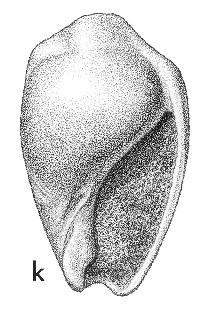
Revised descriptions of New Zealand Cenozoic Mollusca from Beu and Maxwell (1990)

 | Revised descriptions of New Zealand Cenozoic Mollusca from Beu and Maxwell (1990) | 
|
  (Pl. 30k): Hurupi Stream, Palliser Bay, southern Wairarapa, from basal coarse grit bed, pres. L. C. King, Tongaporutuan (GNS) |
Beu & Maxwell (1990): Chapter 13; p. 268; pl. 30 k.
Synonymy: Ancilla (Baryspira) tirangiensis Marwick 1926c, p. 324
Classification: Olividae: Ancillinae
Description: Large for subfamily (47-65 mm high), with spire low (third to quarter height of aperture), conic or dome-shaped, with flat apex on some specimens; prominent, rounded shoulder angulation above top of aperture; parietal callus enormously developed. Spire callus descends to upper third of last whorl, well below top of aperture, and is deeply grooved above posterior canal of aperture. Parietal callus descends to below half height of inner lip, obliterating upper part of basal groove and all fasciolar bands; only moderately convex on its ventral face, but greatly swollen into a lobe anteriorly, to left of upper columellar area; its left margin is strongly convex but swings back again at shoulder angle to thicken only apertural side of spire. Lower columella smooth; most fasciolar bands weakly denned; depressed band wide, strongly depressed, pale reddish brown on some well preserved Palliser Bay shells; wide band occupies central third of last whorl. Inner lip strongly excavated near centre, i.e., parietal area at strong angle to lower columella; outer lip weakly thickened, only weakly convex, smooth except for slight protrusion of depressed band.
Comparison: Amalda tirangiensis is the youngest, largest, and most heavily callused of the wide-spired group of species so common in the New Zealand middle Cenozoic. The possibly ancestral species A. robusta (Duntroonian-Altonian; Pl. 22h) and A. platycephala (Otaian-Altonian) are similar but their parietal callus is not so long, hiding little of the fasciolar bands and groove, and A. platycephala does not reach such a large size. A broken specimen of A. tirangiensis from Palliser Bay is 35 mm wide and is estimated to have been 65 mm high; its depressed band and wide band are brown, whereas lower fasciolar bands are white.
Distribution: Tongaporutuan; Tirangi Stream, North Taranaki (type) and widespread in shallow-water, diverse assemblages in North Taranaki, southern Hawke's Bay, Wairarapa, and North Canterbury. Uncommon at most localities, but reasonably common in the Hurupi Stream area, eastern Palliser Bay.
Cite this publication as: "A.G. Beu and J.I. Raine (2009). Revised
descriptions of New Zealand Cenozoic Mollusca from Beu and Maxwell (1990). GNS
Science miscellaneous series no. 27."
© GNS Science, 2009
ISBN
978-0-478-19705-1
ISSN 1177-2441
(Included with a PDF facsimile file
copy of New Zealand Geological Survey Paleontological Bulletin 58 in CD version
from: Publications Officer, GNS Science, P.O. Box 30368 Lower Hutt, New
Zealand)